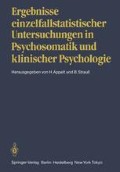Zusammenfassung
Wenn wir als Therapeuten vom Geschehen in einer Therapie berichten, so verwenden wir als Referenzeinheit oft eine Stunde. Wir sprechen von einer “guten Stunde”, “miesen Stunde” etc., ohne jedoch immer genau angeben zu können, was wir damit meinen oder worauf sich dieses Urteil gründet.
Mit Unterstützung der DFG (SFB 115, Projekt BO)
Access this chapter
Tax calculation will be finalised at checkout
Purchases are for personal use only
Preview
Unable to display preview. Download preview PDF.
Literatur
Apel K-O (1975) Szientistik, Hermeneutik, Ideologiekritik. Entwurfeiner Wissenschaftslehre in erkenntnisanthropologischer Sicht. In: K-O Apel (Hrsg) Hermeneutik und Dialektik. Suhrkamp, Frankfurt
Auerbach AH, Luborsky L (1968) Accuracy of judgements of psychotherapy and the nature of the “good hour”. Res Psychother 3: 155–168
Attneave F (1974) Informationstheorie in der Psychologie. Huber,Bern
Bachrach HM (1976) Empathy - we know what we mean, but what do we measure? Arch Gen Psychiat 33: 35–38
Bally G (1961) Einführung in die Psychoanalyse Sigmund Freuds. Ro-wohlt, Reinbek
Cattell RB (1951) P technique: A new method for analyzing the struc-ture of personal motivation. Transactions Ser.II 14: 29–34
Cattell RB (1963) The structure of change by P technique and incre-mental R technique. In: C Harris (Ed) Problems in measuring change. University of Wisconsin Press, Madison
Cremerius J (1971) Neurose und Genialität. Fischer, Frankfurt
Dahl H (1972) A quantitative study of psychoanalysis. In: RR Holt, E Peterfreund (Eds): Psychoanalysis and contemporary science. Macmillan, New York
Deneke F-W, Stuhr U, Burzig G (1979) Dimensions of clinical judgement. Vortrag auf dem IX. Int. Kongress für Psychotherapie, Am- sterdam
Fenichel O (1974) Psychoanalytische Neurosenlehre. Walter, Olten
Görres A (1958) Methoden und Erfahrungen der Psychoanalyse. Kösel, München
Greenson RR (1973) Technik und Praxis der Psychoanalyse (Bd.I). Klett, Stuttgart
Habermas J (1975) Erkenntnis und Interesse. Suhrkamp, Frankfurt
Holtzman WH (1962) Methodological issues in P-technique. Psychol Bull 59: 248–256
Klix F (1973) Information und Verhalten. Verlag der Wissenschaften, Berlin
Krambeck J, Lorenzer A (1974) Verstehen, Hermeneutik und “falsches Verständigtsein”. In: WJ Schraml, U Baumann (Hrsg): Klinische Psychologie II. Huber, Bern
Lienert GA (1973) Verteilungsfreie Methoden der Biostatistik Bd I. Hain, Meisenheim
Loch W (1966) Ober einige allgemeine Strukturmerkmale und Funktionen psychoanalytischer Deutungen. Psyche 20: 377–397
Loch W (1976) Psychoanalyse und Wahrheit. Psyche 30: 865–898
Luborsky L (1953) Repeated intra-individual measurements (P-tech-nique) in understanding symptom structure and therapeutic change. In: OH Mowrer (Ed): Psychotherapy: theory and research. Ronald Press, New York
Marsden G (1971) Content analysis studies of psychotherapy: 1954 through 1968. In AE Bergin, SL Garfield (Eds): Handbook of psy-chotherapy and behavior change. Wiley, New York
Mefferd RB (1966) Structuring physiological correlates of mental processes and states: The study of biological correlates of mental processes. In: RB Cattell (Ed): Handbook of multivariate experimental psychology. Rand McNally, Chicago
Meyer A-E (Hrsg) (1981) The Hamburg short psychotherapy comparison experiment. Psychotherapy and psychosomatics 35: 2–3
Meyer-Eppler W (1959) Grundlagen und Anwendungen der Informationstheorie. Springer, Berlin
Mintz J, Luborsky L (1970) P-technique factor analysis in psychotherapy research: An illustration of a method. Psychother Theor Res Pract 7: 13–18
Mintz J, Luborsky L, Auerbach AH (1971) Dimensions of psychotherapy: A factor analytic study of ratings of psychotherapy sessions. J cons clin Psychol 36: 106–120
Orlinsky DE, Howard KI (1967) The good therapy hour. Arch Gen Psychiat 16: 621–632
Rapaport D (1973) Die Struktur der psychoanalytischen Theorie. Klett, Stuttgart
Remplein S (1977) Therapieforschung in der Psychoanalyse. Reinhardt, München
Revenstorf D, Vogel B (1979) Zur Analyse qualitativer Verlaufsdaten - ein überblick. In: F Petermann, FJ Hehl (Hrsg): Einzelfallanalyse. Urban & Schwarzenberg, München
Ricoeur P (1974) Die Interpretation. Ein Versuch über Freud. Suhr-kamp, Frankfurt
Schröter K (1974) Psychoanalytischer Dialog und alltägliche Kommuni-kation. In: M Muck, K Schörter, R Kluwer, U Eberenz, K Kennel, K Horn (Hrsg): Information über Psychoanalyse. Suhrkamp, Frankfurt
Stemmler G (1981) INZU. Informationstheoretische Zusammenhangsmaße. Programmbibliothek der Forschungsgruppe C21 des SFB 115, Hamburg
Stuhr U (1984) Deutungsarbeit im psychoanalytischen Dialog. Vanden-hoek u. Ruprecht, Göttingen
Taylor C (1975) Erklärung und Interpretation in den Wissenschaften vom Menschen. Suhrkamp, Frankfurt
Thomä H (1974) Zur Rolle des Psychoanalytikers in psychotherapeu-tischen Interaktionen. Psyche 28: 381–394
Thomä H, Kächele H (1973) Wissenschaftstheoretische und methodolo-gische Probleme in der klinisch-psychoanalytischen Forschung. Psyche 27: 203–236 u. 309–351
Editor information
Editors and Affiliations
Rights and permissions
Copyright information
© 1985 Springer-Verlag Berlin Heidelberg
About this chapter
Cite this chapter
Stuhr, U. (1985). Informationstheoretische Analyse von Therapie-Stunden. In: Appelt, H., Strauß, B. (eds) Ergebnisse einzelfallstatistischer Untersuchungen in Psychosomatik und klinischer Psychologie. Springer, Berlin, Heidelberg. https://doi.org/10.1007/978-3-642-69817-0_7
Download citation
DOI: https://doi.org/10.1007/978-3-642-69817-0_7
Publisher Name: Springer, Berlin, Heidelberg
Print ISBN: 978-3-540-13512-8
Online ISBN: 978-3-642-69817-0
eBook Packages: Springer Book Archive

